Energy Conservation and Emissions Reduction in China’s Power Sector: Alternative Scenarios Up to 2020
Abstract
:1. Introduction
2. Current Situation of China’s Power Sector and Comparison with U.S.
2.1. The Current Situation of China’s Power Sector
2.2. Power Sector Comparison between China and the U.S.
3. Key Actions and Achievements of ECER in China’s Power Sector
3.1. Actions and Achievements in Optimizing the Power Generation Mix
3.2. Actions and Achievements in Adjusting Coal Power Generation Mix
3.3. Actions and Achievements in Energy Efficiency Benchmarking
3.4. Actions and Achievements in Transmission and Distribution (T&D) Network
3.5. Actions and Achievements in Developing Clean Coal Technologies (CCTs)
3.6. Actions and Achievements in Improving Energy Efficiency
4. ECER in China’s Power Sector into 2020
4.1. Baseline Scenario
4.2. ECER Scenario
4.2.1. Contribution from Technical and Operational Improvements
4.2.2. Contribution from Improvements in Generation Mix
Structural Improvement of Coal Power
Ambitious Clean Generation
4.2.3. Contribution from DSM
4.2.4. Total Potential of Energy Conservation Scenario
5. Conclusions and Policy Implications
- 1
- Attracting both domestic and overseas capital to invest in developing high-efficient and low-emissions coal power generation; imposing emissions tax or fossil energy tax and pricing policies on coal power to improve the effectiveness of economic incentives for generation corporations.
- 2
- Promoting energy-saving dispatch policies; expanding trans-regional transmissions; developing the technology of energy storage and forecasting to consume large amounts of renewable power, raising the proportion of renewable energy through the pricing policies in the power sector.
- 3
- Improving the sense of enterprise and individual’s social responsibility and enthusiasm to change the way in using power and improve terminal energy efficiency; and conducting market reform (including pricing mechanism reform in particular) to further implement DSM measures.
Acknowledgments
Author Contributions
Conflicts of Interest
Abbreviations
| BAU | business-as-usual |
| CCTs | clean coal technologies |
| ECER | energy conservation and emissions reduction |
| CEC | China Electricity Council |
| CFB | circulating fluidized bed combustion |
| DSM | Demand Side Management |
| EEC | electricity elastic coefficient |
| IGCC | integrated gasification combined cycle |
| NDRC | National Development and Reform Commission |
| NEA | National Energy Administration |
| SBC | sub-critical |
| SCC | State Council of China |
| SERC | State Electricity Regulatory Commission |
| SOE | state owned enterprise |
| T&D | transmission and distribution |
| USC | ultra-supercritical |
References
- Liu, T.; Xu, G.; Cai, P.; Tian, L.H.; Huang, Q.L. Development forecast of renewable energy power generation in China and its influence on the GHG control strategy of the country. Renew. Energy 2011, 36, 1284–1292. [Google Scholar] [CrossRef]
- Geng, J.; Lu, Y.L.; Wang, T.Y.; Giesy, J.P.; Chen, C.L. Effects of energy conservation in major energy-intensive industrial sectors on emissions of polychlorinated dibenzo-p-dioxins and polychlorinated dibenzofurans in China. Energy Policy 2010, 38, 2346–2356. [Google Scholar] [CrossRef]
- Wen, Z.G.; Li, H.F. Analysis of potential energy conservation and CO2 emissions reduction in China’s non-ferrous metals industry from a technology perspective. Int. J. Greenh. Gas Control 2014, 28, 45–56. [Google Scholar] [CrossRef]
- Peng, L.H.; Zeng, X.L.; Wang, Y.J.; Hong, G.B. Analysis of energy efficiency and carbon dioxide reduction in the Chinese pulp and paper industry. Energy Policy 2015, 80, 65–75. [Google Scholar] [CrossRef]
- Kong, L.B.; Hasanbeigi, A.; Price, L.; Liu, H.B. Energy conservation and CO2 mitigation potentials in the Chinese pulp and paper industry. Resour. Conserv. Recycl. 2015. [Google Scholar] [CrossRef]
- Li, K.; Lin, B.Q. The efficiency improvement potential for coal, oil and electricity in China's manufacturing sectors. Energy 2015, 86, 403–413. [Google Scholar] [CrossRef]
- Zhao, G.L.; Chen, S. Greenhouse gas emissions reduction in China by cleaner coal technology towards 2020. Energy Strategy Rev. 2015, 7, 63–70. [Google Scholar] [CrossRef]
- Liu, Y.M.; Guo, W.J. Effects of energy conservation and emission reduction on energy efficiency retrofit for existing residence: A case from China. Energy Build. 2013, 61, 61–72. [Google Scholar] [CrossRef]
- Xu, J.H.; Fan, Y.; Yu, S.M. Energy conservation and CO2 emission reduction in China’s 11th Five-Year Plan: A performance evaluation. Energy Econ. 2014, 46, 348–359. [Google Scholar] [CrossRef]
- Zhao, Z.Y.; Chang, R.D.; Zillante, G. Challenges for China’s energy conservation and emissions reduction. Energy Policy 2014, 74, 709–713. [Google Scholar] [CrossRef]
- Gu, Y.; Li, C. Construction of evolution indicator system of energy conversation and emissions reduction in China’s power sector. J. Shenyang Technol. 2013, 01, 73–76. (In Chinese) [Google Scholar]
- Yang, Z.; Mao, Y. Energy conversation and emissions reduction and low-carbon economy in China’s power sector. J. Environ. Manag. Coll. China 2010, 01, 1–4. (In Chinese) [Google Scholar]
- Chen, Z.; Yu, W. Research on technologies and potential of energy conversation and emissions reduction in China’s power sector. Sci. Technol. Guangdong 2009, 12, 1–3. (In Chinese) [Google Scholar]
- Wu, X. Analysis on polices and technologies of energy conversation and emissions reduction in China’s power sector. Environ. Prot. Circ. Econ. 2008, 3, 23–24. (In Chinese) [Google Scholar]
- Li, L.; Tan, Z.F.; Wang, J.H.; Xu, J.; Cai, C.K.; Hou, Y. Energy conservation and emission reduction policies for the electric power industry in China. Energy Policy 2011, 39, 3669–3679. [Google Scholar] [CrossRef]
- Yuan, J.; Kang, J.; Yu, C.; Hu, Z.G. Energy conservation and emissions reduction in China—Progress and prospective. Renew. Sustain. Energy Rev. 2011, 15, 4334–4347. [Google Scholar] [CrossRef]
- Statistical Data for China’s Power Sector in 2014. Available online: http://www.cec.org.cn/guihuayutongji/tongjxinxi/niandushuju/2015-11-30/146012.html (accessed on 1 January 2016).
- Interpretation of Electrical Elasticity Coefficient in China since 2014. Available online: http://hvdc.chinapower.com.cn/news/1037/10378994.asp (accessed on 1 January 2016).
- Statistical Data for China’s Power Sector in 2009. Available online: http://www.cec.org.cn/guihuayutongji/tongjxinxi/niandushuju/2013-04-19/100587.html (accessed on 23 September 2013).
- Statistical Data for China’s Power Sector in 2010. Available online: http://www.cec.org.cn/guihuayutongji/tongjxinxi/niandushuju/2013-04-19/100588.html (accessed on 23 September 2013).
- Statistical Data for China’s Power Sector in 2011. Available online: http://www.cec.org.cn/guihuayutongji/tongjxinxi/niandushuju/2013-04-19/100589.html (accessed on 23 September 2013).
- Statistical Data for China’s Power Sector in 2012. Available online: http://www.cec.org.cn/guihuayutongji/tongjxinxi/ (accessed on 23 September 2013).
- Statistical Data for China’s Power Sector in 2013. Available online: http://www.cec.org.cn/guihuayutongji/tongjxinxi/yuedushuju/2014-01-26/116224.html (accessed on 23 September 2013).
- Main Economic and Technical Indicators of China’s Top Five SOE and Guohua Generators. Available online: http://www.cec.org.cn/yaowenkuaidi/2014-02-26/117351.html.(accessed on 23 September 2013).
- Report on Analysis and Forecasting of the Power Supply and Demand for 2016. Available online: http://www.cec.org.cn/yaowenkuaidi/2016-02-03/148763.html (accessed on 19 February 2016).
- Statistical Data for China’s Power Sector in 2015. Available online: http://www.cec.org.cn/guihuayutongji/tongjxinxi/yuedushuju/2015-12-17/146910.html (accessed on 1 January 2016).
- CESY (China Statistical Yearbook, 2015). Available online: http://www.stats.gov.cn/tjsj/ndsj/2015/indexch.htm (accessed on 1 January 2016).
- Hu, J.; Kahrl, F.; Ding, J. Comparison China’s power industry with the US for climate change. Chin. Mark. 2011, 07, 49–55. (In Chinese) [Google Scholar]
- BP Statistical Review of World Energy. Available online: http://www.bp.com/en/global/corporate/about-bp/energy-economics/statistical-review-of-world-energy-2015.html (accessed on 1 January 2016).
- Renewable energy integrated entirely by power grid. Available online: http://www.pinghe.gov.cn/cms/html/xzfwz/2010-08-13/1551147629.html (accessed on 23 September 2013).
- Notice on Renewable Energy Subsidies Price and Rationing Transaction. Available online: http://jgs.ndrc.gov.cn/zcfg/200709/t20070930_163465.html (accessed on 23 September 2013).
- How to Understand the New 6 Supporting Documents of the Power System Reform. Available online: http://www.ndrc.gov.cn/zcfb/jd/201512/t20151201_761159.html (accessed on 20 December 2015).
- Roadmap for High-Efficiency, Low-Emissions Coal-Fired Power Generation. Available online: http://www.iea.org/media/publications/HELE_roadmap_CN.pdf (accessed on 1 January 2014).
- Notice on the Closure of Small Thermal Units. Available online: http://bgt.ndrc.gov.cn/zcfb/200701/t20070131_498187.html (accessed on 23 September 2013).
- Notice on energy efficiency benchmarking for key energy-consuming enterprises. Available online: http://www.gdei.gov.cn/zwgk/tzgg/2007/200712/P020071224680245564760.doc (accessed on 23 September 2013).
- Notice on Energy Conservation and Emissions Abatement for 2010. Available online: http://www.serc.gov.cn/ywdd/201110/t20111026_15467.html (accessed on 22 September 2013).
- Rules on Energy Conservation Dispatch (Trial). Available online: http://www.ndrc.gov.cn/zcfb/zcfbqt/200708/t20070828_156042.html (accessed on 23 September 2013).
- Guan, Y.; Wang, G.; Zhao, C; Sun, R.; Li, Q. Analysis and solutions of energy-saving generation dispatch of Jiangsu power grid. Electr. Power 2011, 09, 4–9. (In Chinese) [Google Scholar]
- Great Achievement by China Southern Power Grid Company Using Energy-saving Generation Dispatch. Available online: http://www.chinapower.com.cn/newsarticle/1119/new1119728.asp (accessed on 15 March 2014).
- White Paper for the Energy Efficiency Status of China Energy-Use Products; China National Institute of Standardization (CNIS): Beijing, China, 2013; pp. 36–37. (In Chinese)
- OECD Statistics. Available online: http://www.oecd.org/statistics/ (accessed on 15 March 2014).
- Notice on the Medium-and-Long-term Plan for Renewable Energy Development. Available online: http://www.gov.cn/zwgk/2007-09/05/content_738243.htm (accessed on 23 September 2013).
- Notice on the Medium-and-Long-term Plan for Nuclear Energy Development. Available online: http://www.gov.cn/gzdt/att/att/site1/20071104/00123f3c4787089759a901.pdf (accessed on 23 September 2013).
- Power Sector Research Report for the 12th FYP Period. Available online: http://www.cec.org.cn/zhuanti/2011nianzhuantihuigu/dianlixingyeshierwuguihua/ (accessed on 23 September 2013).
- Renewable Energy Development Plan for the 12th FYP. Available online: http://www.nea.gov.cn/201208/08/c_131767651.htm (accessed on 23 September 2013).
- Action Plan of Transformation and Upgrading of Coal Power for Energy Conservation and Emissions Reduction 2014–2020. Available online: http://www.sdpc.gov.cn/zcfb/zcfbtz/201409/t20140919_626235.html (accessed on 16 October 2014).
- Annual Development Report of China’s Power Sector-2013; China Market Press: Beijing, China, 2014; p. 18. (In Chinese)
- Han, Z.; Liu, S.; Li, Z.; Liu, X.; Hong, Z. Comparison of power generation schemes using clean coal and traditional fuel coal. Therm. Power Gener. 2012, 02, 1–3. (In Chinese) [Google Scholar]
- Grid Access Wind Power and the Curtailment Rate. Available online: http://www.cpnn.com.cn/zdyw/201502/t20150212_783277.html (accessed on 14 February 2015).
- Notice on Grid Access Wind Power Consumption. Available online: http://zfxxgk.nea.gov.cn/auto87/201404/t20140414_1787.htm (accessed on 14 February 2015).
- Several Opinions on Promoting the Healthy Development of Photovoltaic Industry. Available online: http://www.gov.cn/zwgk/2013-07/15/content_2447814.htm (accessed on 30 March 2015).
- Baskette, C.; Horii, B.; Kollmanb, E.; Pricea, S. Avoided cost estimation and post-reform funding allocation for California’s energy efficiency programs. Energy 2006, 1, 1084–1099. [Google Scholar] [CrossRef]
- Energy Saving Management Experience for Foreign Countries. Available online: http://wenku.baidu.com/link?url=Cq2Y1RwwaB-bP3A_CROqcr3GiL1zpEb8SyoNEDwmuehTr9h6ZyzpFCNV8bkXZY2KbaW1fhKhlgWnwxL-Jo_aB7jGj2pYRtC8_jsSj77MKT7 (accessed on 23 September 2013).
- Yuan, J.H.; Xu, Y.; Zhang, X.P.; Hu, Z.; Xu, M. China’s 2020 clean energy target: Consistency, pathways and policy implications. Energy Policy 2014, 65, 692–700. [Google Scholar] [CrossRef]
- World Energy Outlook 2007—China and India Insights-Special Report Focus on China and India. Available online: http://www.iea.org/publications/freepublications/publication/weo_2007.pdf (accessed on 23 September 2014).
- Green Book of Climate Change: Annual Report on Actions to Address Climate Change (2013). Available online: http://www.cma.gov.cn/2011xzt/2013zhuant/20131107/ (accessed on 23 September 2014).
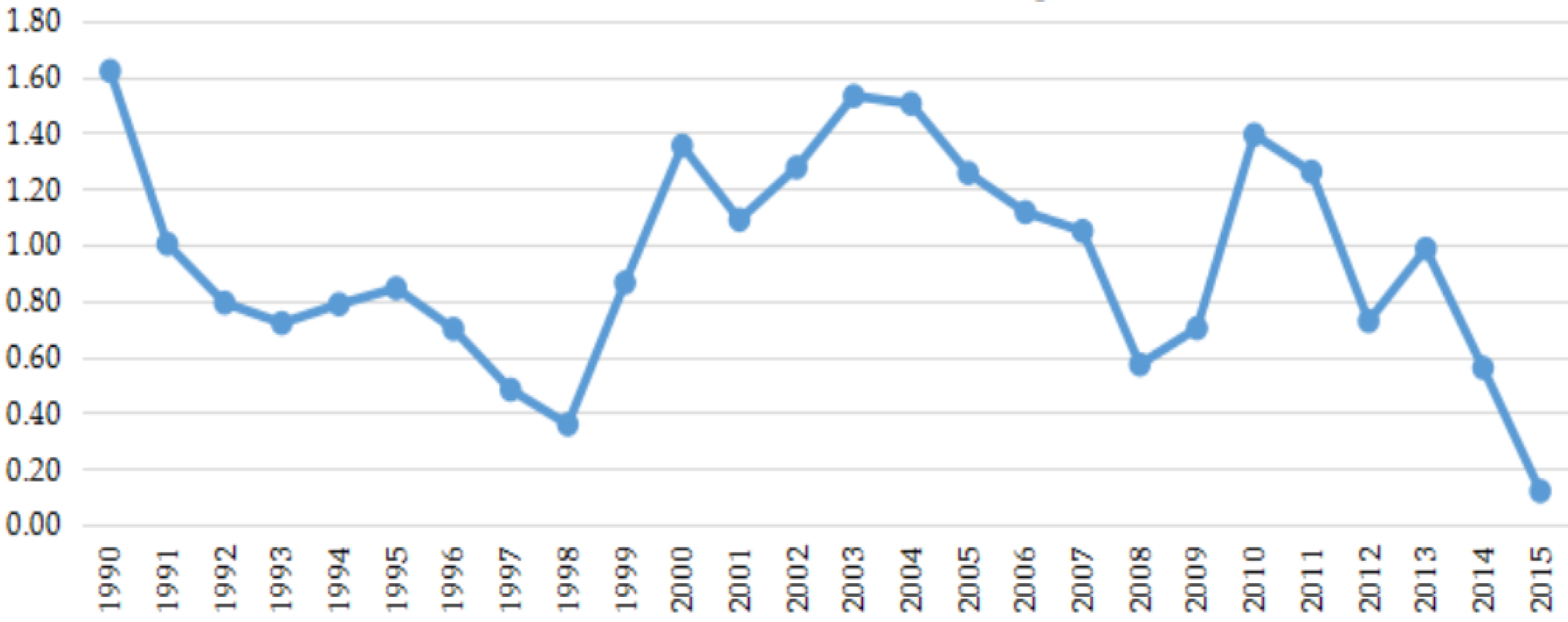
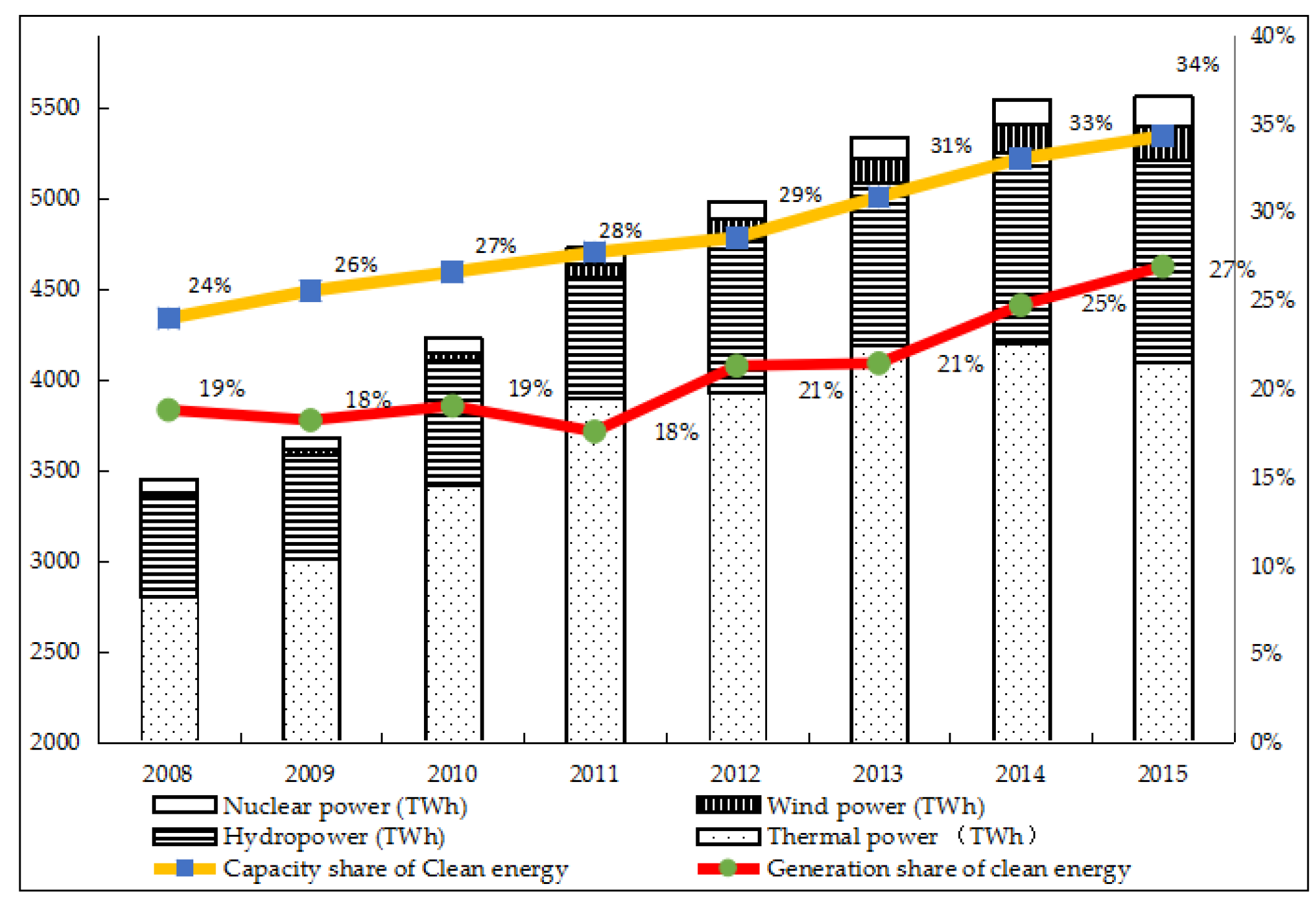

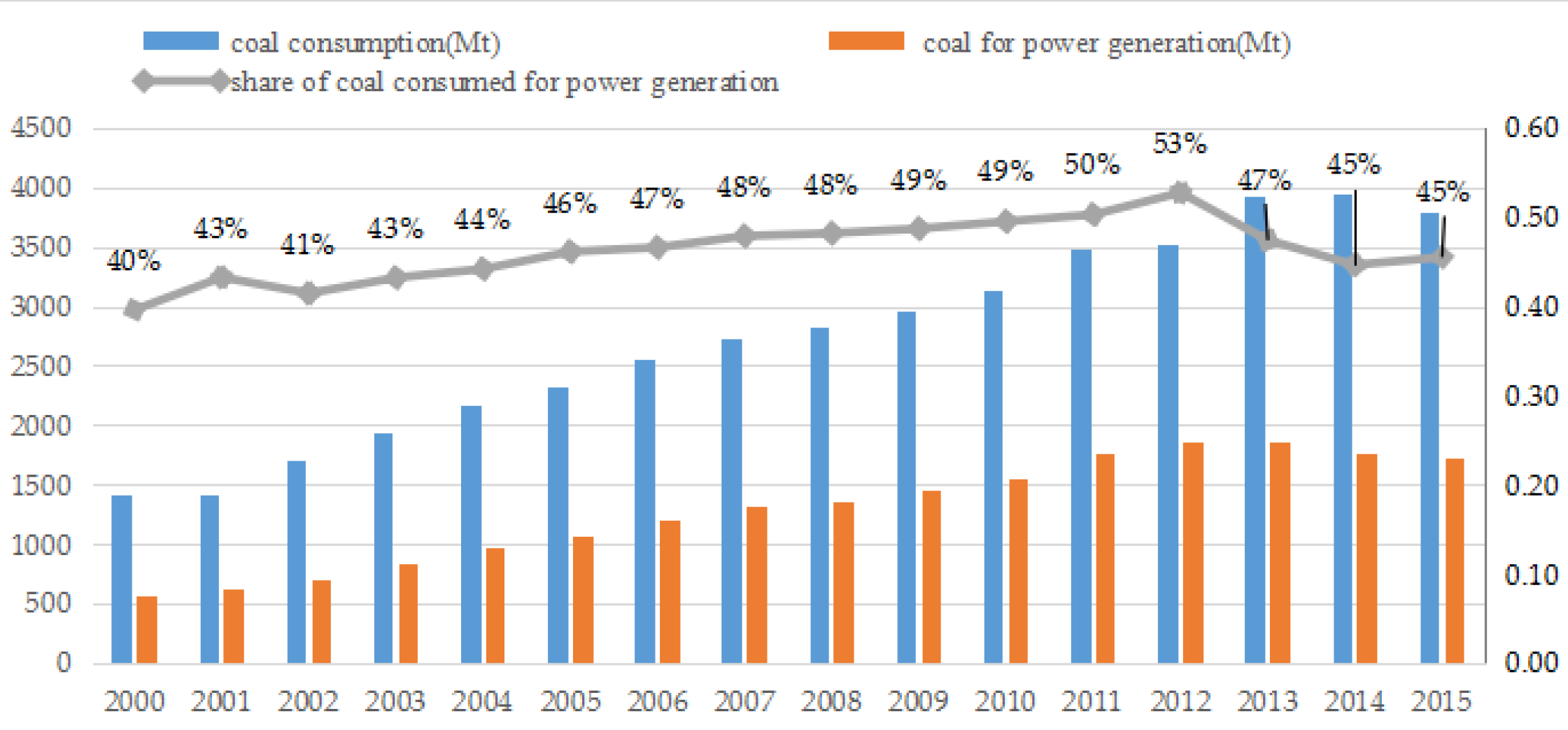
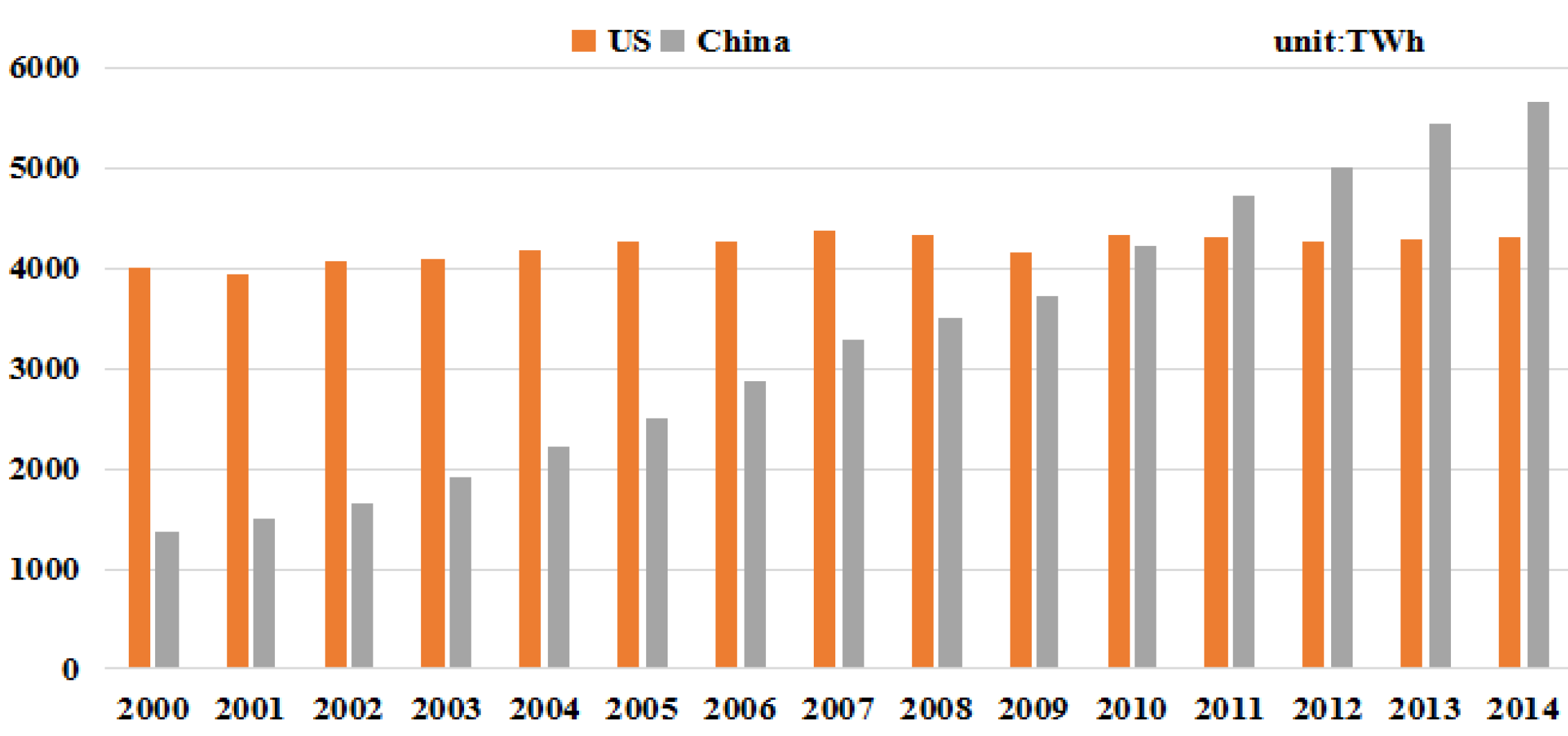
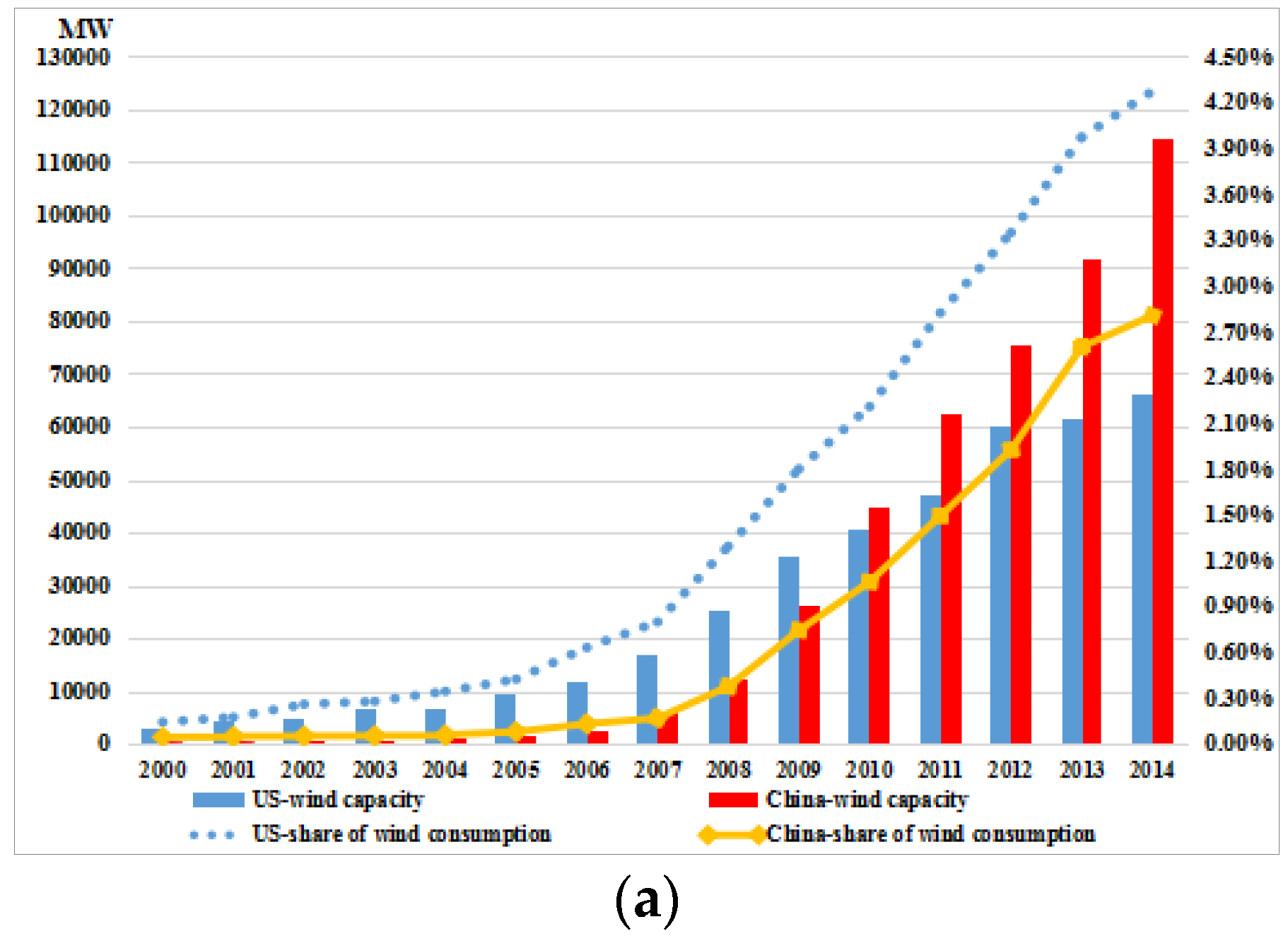
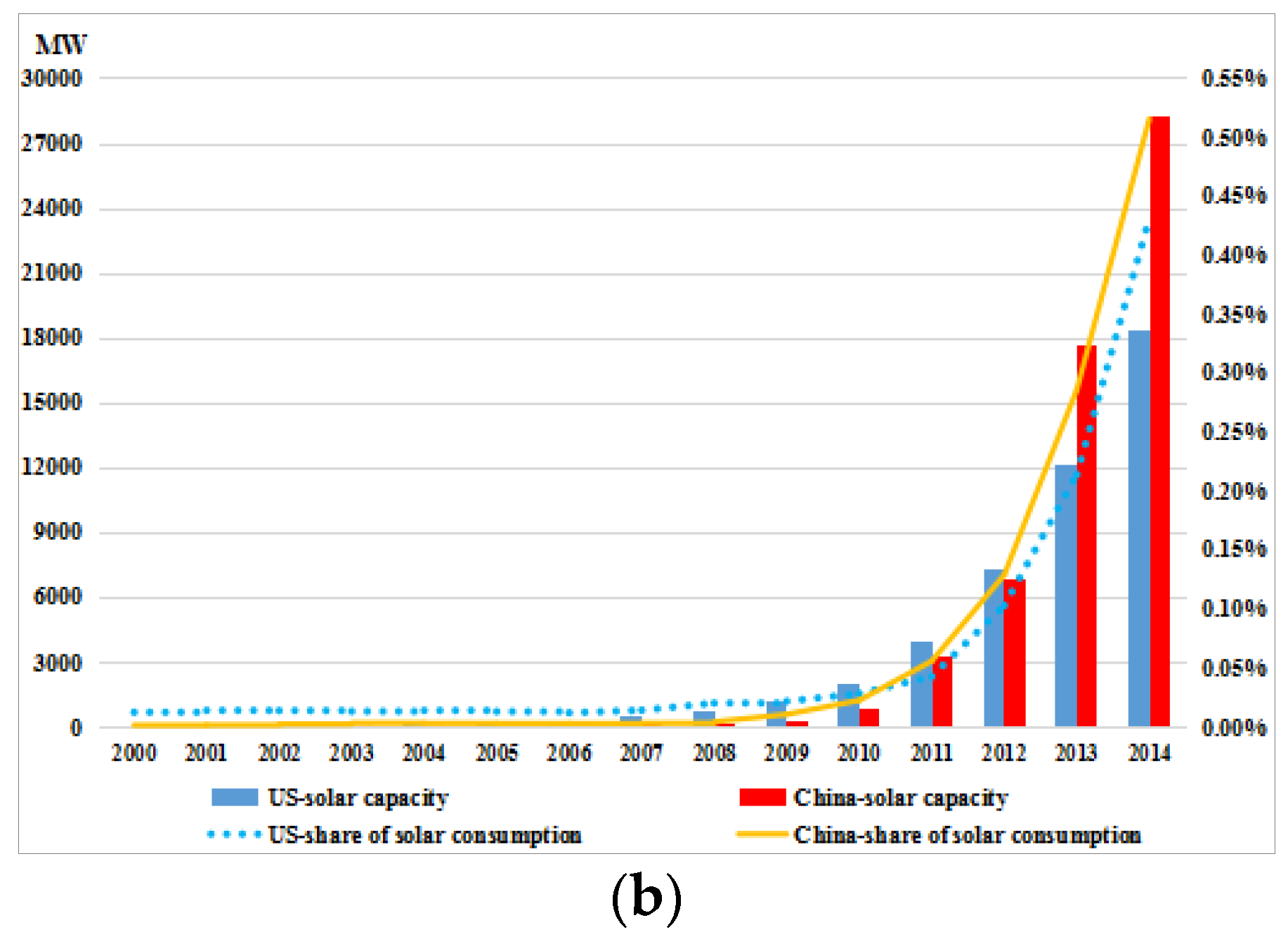


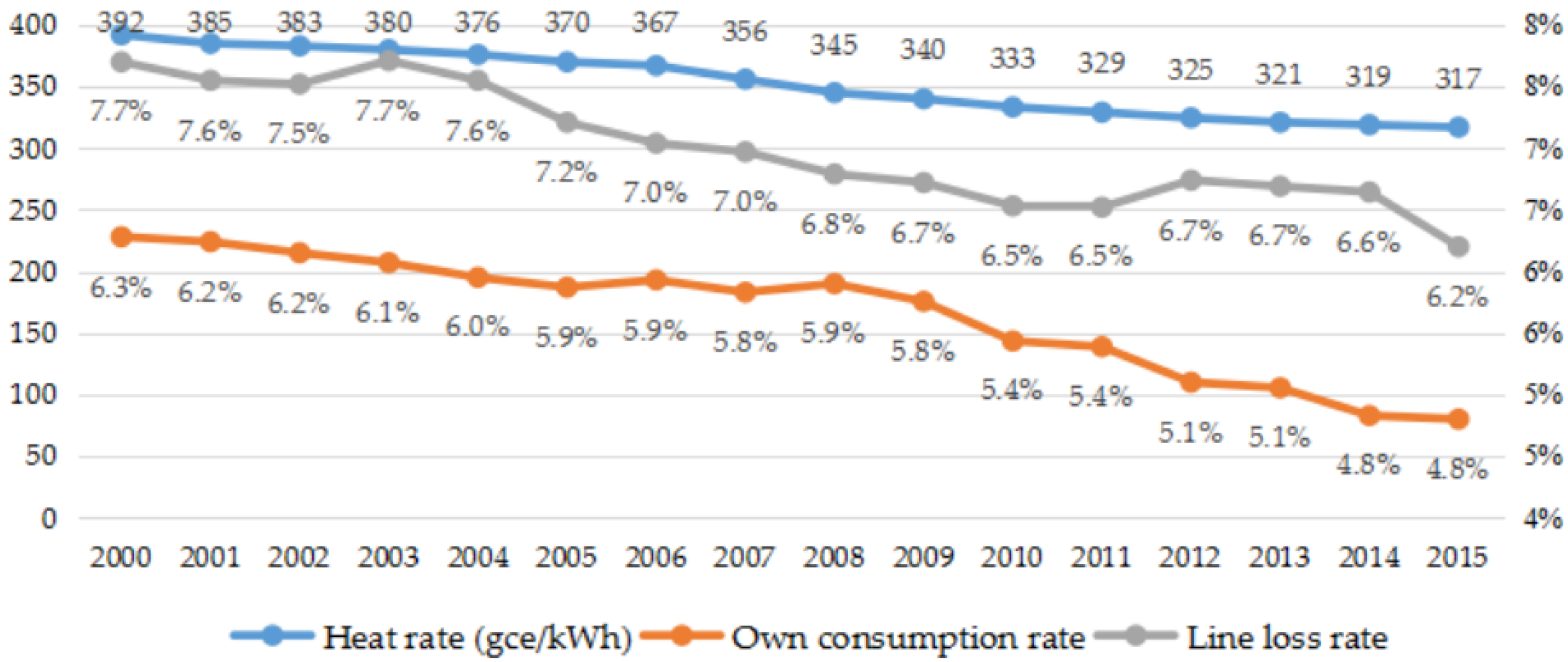
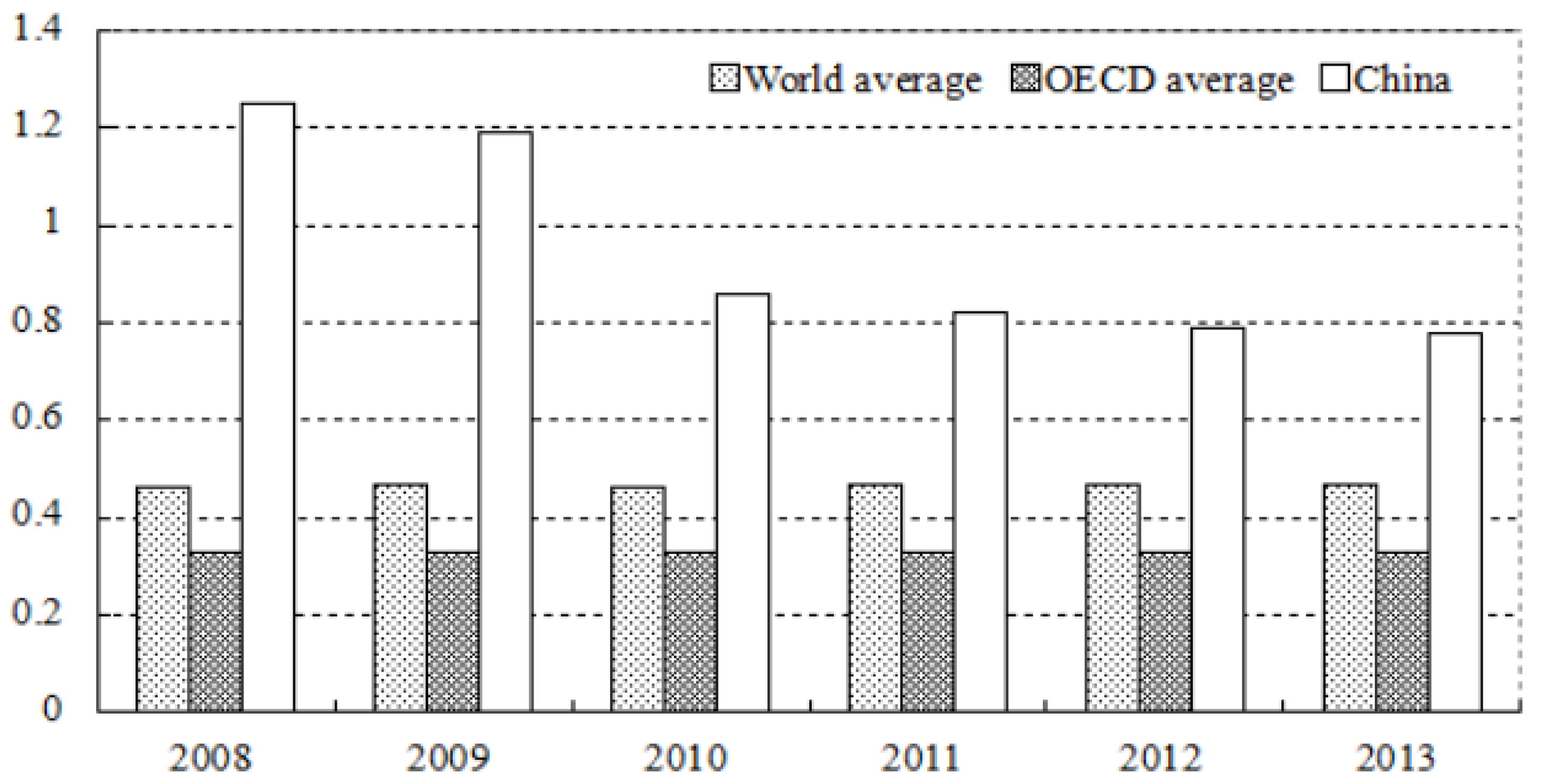
| Year | 2006 | 2007 | 2008 | 2009 | 2010 | 2011 | 2012 | 2013 | 2014 |
|---|---|---|---|---|---|---|---|---|---|
| Closed capacity (GW) | 3.14 | 14.36 | 16.68 | 26.17 | 16.90 | 3.46 | 6.16 | 4.47 | 9.09 1 |
| Technology | Thermal Efficiency (%) | Coal Consumption (gce/kWh) | Overnight Cost ($/kW) | Emissions | ||
|---|---|---|---|---|---|---|
| CO2 (g/kWh) | SO2 (mg/m3) | NOx (mg/m3) | ||||
| SBC | <38% | >380 | 600–1980 | 950–1080 | <60–280 | <330–420 |
| SC | 42–43% | 340–380 | 700–2310 | 920–960 | <100–150 | <300–500 |
| CFB | 38–40% | -- | -- | 880–900 | <50–100 | <200 |
| USC | 45% | 320–340 | 800–2530 | 740 | <20–100 (+FGD) | <50–100 (+SCR) |
| IGCC | 45–50% | 290–320 | 1100–2860 | 670–740 | <20 | <30 |
| Relevant Plans | Time Issued | Hydro | Wind | Nuclear | Solar | Biomass | Gas | Coal |
|---|---|---|---|---|---|---|---|---|
| NDRC [42] | 2007.8 | 300 | 30 | -- | 1.8 | 30 | -- | -- |
| NDRC [43] | 2007.10 | -- | -- | 40 | -- | -- | -- | -- |
| CEC [44] | 2012.3 | 330 | 180 | 80 | 25 | 5 | 43 | 1160 |
| NEA [45] | 2012.8 | 420 | 200 | -- | 50 | -- | -- | -- |
| Baseline | -- | 420 | 200 | 40 | 50 | 30 | 43 | 1160 |
| Item | Own Consumption Rate | Line Loss | Heat Rate |
|---|---|---|---|
| BAU scenario | 5% | 6.2% | 310 gce/kWh |
| ECER scenario | 4.18% | 5.7% | 307 gce/kWh |
| Contribution | Primary Energy Conservation (Mtce) | CO2 Abatement (Mt) | SO2 Abatement (Mt) | NOx Abatement (Mt) |
|---|---|---|---|---|
| Self-consumption (4.18%) | 15.69 | 62.07 | 0.42 | 0.39 |
| Line loss (5.7%) | 9.57 | |||
| Total | 25.26 |
| Capacity Type (MW) | Subtotal (GW) | Share (%) | Annual Operation (h) | Heat Rate (gce/kWh) |
|---|---|---|---|---|
| Unit ≥ 1000 | 58.37 | 9.31 | 5400 | 292 |
| 600 ≤ unit < 1000 | 247.21 | 39.65 | 5122 | 313 |
| 300 ≤ unit < 600 | 238.98 | 38.36 | 4525 | 322 |
| 200 ≤ unit < 300 | 42.04 | 6.74 | 4451 | 342 |
| Unit <200 | 36.54 | 5.94 | 4713 | 365 |
| Technology | Steam Temperature (°C) | Steam Pressure (MPa) | Thermal Efficiency (%) | Heat Rate (gce/kWh) |
|---|---|---|---|---|
| Medium temperature & pressure | 435 | 35 | 24 | 480 |
| High temperature & pressure | 500 | 90 | 33 | 390 |
| Ultrahigh pressure | 535 | 13 | 35 | 360 |
| SBC | 545 | 17 | 38 | 324 |
| SC | 566 | 24 | 41 | 300 |
| USC | 600 | 27 | 43 | 284 |
| 700 °C USC | 700 | 35 | >46 | 210 |
| Capacity Type (MW) | Share (%) | Subtotal (GW) | Heat Rate (gce/kWh) | Primary Energy Conservation (Mtce) | Abatement (Mt) | ||
|---|---|---|---|---|---|---|---|
| CO2 | SO2 | NOx | |||||
| Unit ≥1000 | 9.31 | 108.00 | 284(8) | 4.67 | 36.56 | 0.25 | 0.23 |
| 600 ≤ unit < 1000 | 52.33 | 607.03 | 300(13) | 40.42 | |||
| 300 ≤ unit < 600 | 38.36 | 444.98 | 322(−15) | −30.20 | |||
| Total | 100 | 1160.00 | -- | 14.88 | |||
| Item | Nuclear | Wind | Solar | Total | Reduced Coal Share | Primary Energy Conservation (Mtce) | Abatement (Mt) | ||
|---|---|---|---|---|---|---|---|---|---|
| CO2 | SO2 | NOx | |||||||
| BAU scenario share (%) | 2.06 | 9.78 | 2.57 | 14.41 | 6.32 | 123.52 | 304.55 | 2.04 | 1.93 |
| Cleaner scenario share (%) | 3.35 | 12.23 | 5.15 | 20.73 | |||||
| Electricity Supply (TWh) | Avoided Demand (TWh) | Primary Energy Conservation (Mtce) | Emissions (Mt) | |||
|---|---|---|---|---|---|---|
| CO2 | SO2 | NOx | ||||
| Without DSM | 8108.70 | 243.26 | 75.90 | 186.46 | 1.25 | 1.18 |
| With DSM | 7865.44 | |||||
| Contribution | Primary Energy Conservation (Mtce) | Abatement (Mt) | ||
|---|---|---|---|---|
| CO2 | SO2 | NOx | ||
| Operation improvement | 25.26 | 62.07 | 0.42 | 0.39 |
| Coal power | 14.88 | 36.56 | 0.25 | 0.23 |
| Clean energy | 123.52 | 304.55 | 2.04 | 1.93 |
| DSM | 75.90 | 186.46 | 1.25 | 1.18 |
| Total | 239.56 | 589.64 | 3.96 | 3.73 |
© 2016 by the authors; licensee MDPI, Basel, Switzerland. This article is an open access article distributed under the terms and conditions of the Creative Commons by Attribution (CC-BY) license (http://creativecommons.org/licenses/by/4.0/).
Share and Cite
Yuan, J.; Na, C.; Hu, Z.; Li, P. Energy Conservation and Emissions Reduction in China’s Power Sector: Alternative Scenarios Up to 2020. Energies 2016, 9, 266. https://doi.org/10.3390/en9040266
Yuan J, Na C, Hu Z, Li P. Energy Conservation and Emissions Reduction in China’s Power Sector: Alternative Scenarios Up to 2020. Energies. 2016; 9(4):266. https://doi.org/10.3390/en9040266
Chicago/Turabian StyleYuan, Jiahai, Chunning Na, Zheng Hu, and Ping Li. 2016. "Energy Conservation and Emissions Reduction in China’s Power Sector: Alternative Scenarios Up to 2020" Energies 9, no. 4: 266. https://doi.org/10.3390/en9040266





